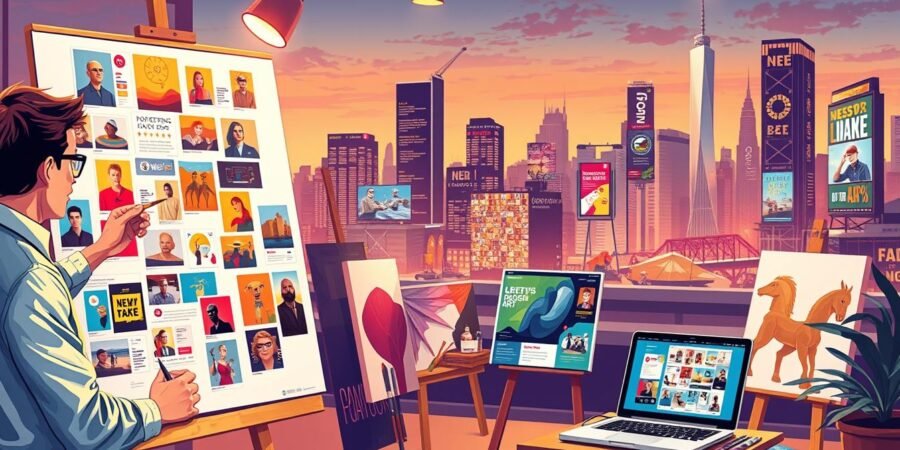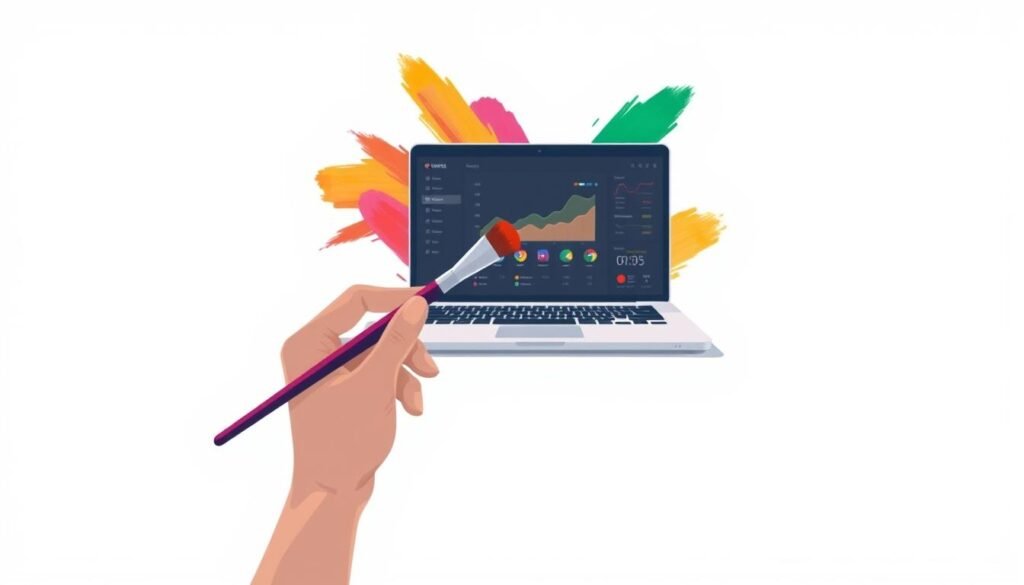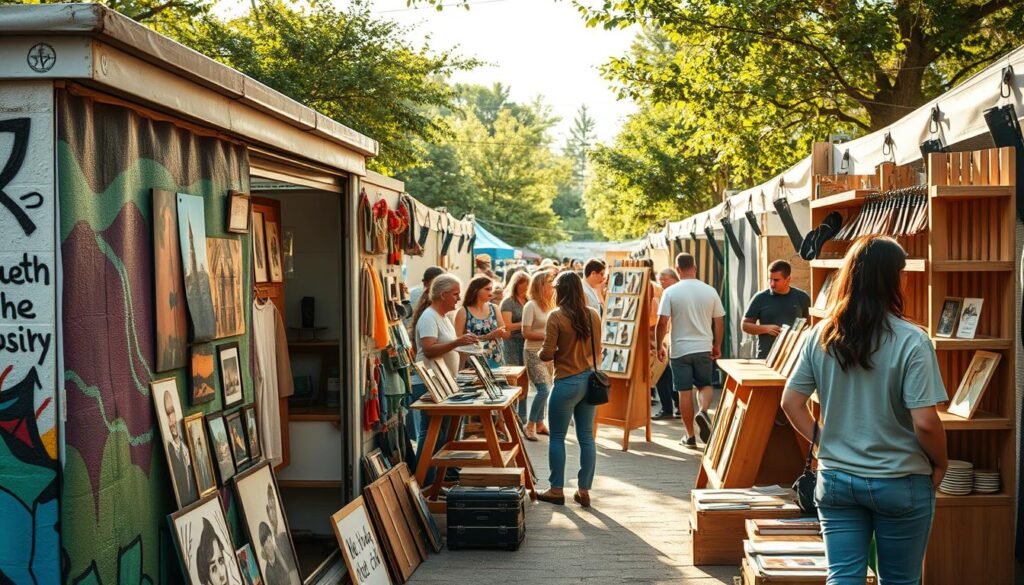In today’s digital age, independent artists have more opportunities than ever to showcase their work beyond the confines of traditional galleries.
Building an online presence is crucial for artists looking to take control of their careers and reach a broader audience.
By leveraging art marketing strategies, artists can now directly connect with potential buyers and fans, creating a more sustainable and fulfilling career path.
Key Takeaways
- Establish a strong online presence through social media and websites.
- Utilize email marketing to directly reach potential buyers and fans.
- Explore alternative platforms for showcasing and selling art.
- Develop a unique brand identity to stand out in the art market.
- Engage with your audience through regular updates and behind-the-scenes content.
The Changing Landscape of Art Promotion
The art world is witnessing a significant shift in how artists promote their work. With the advent of digital technologies and changing consumer behaviors, the traditional gallery model is being challenged.
Why Artists Are Moving Beyond Traditional Galleries
Many artists are finding that traditional galleries may not be the best fit for their work or career goals. Limitations in exposure, commission fees, and curatorial decisions can hinder an artist’s ability to reach their full potential. For instance, a study by the Art Market Report highlighted that nearly 60% of artists felt constrained by the traditional gallery system.
“The traditional gallery system can be restrictive, making it difficult for artists to gain the exposure they need.”
The Benefits of Independent Art Promotion
Independent art promotion offers numerous benefits, including greater control over one’s career and artistic direction. By building an online presence, artists can reach a global audience, engage directly with potential buyers, and promote their work without the intermediary costs associated with traditional galleries.
| Promotion Method | Benefits | Limitations |
|---|---|---|
| Traditional Galleries | Physical exposure, curatorial support | Commission fees, limited control |
| Independent Online Promotion | Global reach, direct sales, creative control | Marketing efforts required, technical skills needed |
By understanding these dynamics, artists can make informed decisions about their promotional strategies.
Building Your Artist Brand Identity
Establishing a strong brand identity is crucial for artists looking to make their mark in the competitive art world. A well-crafted brand identity not only sets you apart from other artists but also helps in promoting your art on social media and other online platforms.
As an independent artist, your brand is a reflection of your unique artistic voice and vision. It’s what collectors and fans will come to recognize and associate with quality and authenticity.
Defining Your Unique Artistic Voice
Your artistic voice is the essence of your brand. It’s what makes your work distinct and relatable. To define it, consider what themes, emotions, or messages you consistently explore in your art. As Marina Abramovic once said, “The role of the artist is to create something that makes people uncomfortable, that challenges their perceptions.”
Creating a Compelling Artist Statement
An artist statement is a written description of your artistic vision and goals. It should be concise, clear, and compelling, providing viewers with a deeper understanding of your work. A good artist statement can be a powerful tool in promoting your art on social media, as it gives context and meaning to your pieces.
Developing a Consistent Visual Identity
Your visual identity includes elements like your logo, color palette, typography, and overall aesthetic. Consistency in these elements across your online presence (website, social media, etc.) reinforces your brand and makes your work instantly recognizable. “Consistency is key to building a strong brand,” notes branding expert
A brand is no longer what we tell the consumer it is—it is what consumers tell each other it is.
– Scott Cook.
By focusing on these key areas, you can develop a robust brand identity that not only showcases your art but also resonates with your target audience, ultimately empowering you to take control of your artistic career.
Creating a Professional Online Portfolio
In today’s digital age, establishing a professional online presence is crucial for artists looking to promote their work beyond traditional gallery settings. A well-designed online portfolio not only showcases an artist’s work but also serves as a powerful tool for non-traditional art marketing and artist self-promotion techniques.
Essential Elements of an Artist Website
An effective artist website should include several key elements. First, it should have a clean and intuitive design that allows visitors to easily navigate through the artist’s work. High-quality images of the artwork are paramount, as they directly impact how potential buyers perceive the art. Additionally, including an artist statement and biography helps visitors understand the context and inspiration behind the work.
Other essential elements include:
- A contact page or form for inquiries
- A calendar or list of upcoming exhibitions or events
- A news or blog section to share updates and insights into the creative process
Choosing the Right Platform for Your Portfolio
Selecting the appropriate platform for your online portfolio is a critical decision. Options range from website builders like Wix and Squarespace to more specialized platforms such as Behance and Format. The choice should be based on the level of customization desired, ease of use, and integration with other tools such as e-commerce solutions for selling art directly.
| Platform | Customization | E-commerce Integration |
|---|---|---|
| Wix | High | Yes |
| Squarespace | High | Yes |
| Behance | Medium | No |
| Format | Medium | Yes |
Photographing Your Art Professionally
High-quality photography is essential for presenting artwork online. Poorly lit or low-resolution images can deter potential buyers, regardless of the artwork’s quality.
Equipment Recommendations for Art Photography
For optimal results, artists should invest in a good camera and appropriate lighting. A DSLR camera with a macro lens can provide the necessary detail.
Lighting and Composition Tips
Proper lighting is critical for accurately capturing the artwork. Natural light is ideal, but if shooting indoors, investing in a lighting kit can help achieve consistent results. Composition should focus on simplicity, ensuring the artwork is the central focus.
“The way you present your work online can make a significant difference in how it’s perceived. High-quality images and a clean, intuitive website design are essential for making a strong impression.”
By focusing on these aspects, artists can create a compelling online portfolio that effectively promotes their work and attracts potential buyers.
How to Promote Your Original Art Without Traditional Galleries Using SEO
In today’s digital age, artists can leverage SEO to promote their original art without relying on traditional galleries. By understanding and implementing effective SEO strategies, artists can increase their online visibility, reach a broader audience, and ultimately drive sales.
Understanding Keywords for Artists
Keywords are the foundation of any SEO strategy. For artists, identifying the right keywords involves understanding what potential buyers are searching for online. This could include terms related to specific art styles, mediums, or themes. Conducting thorough keyword research is essential to identify relevant terms that can be incorporated into your website content, social media, and other online platforms.
Tools like Google Keyword Planner and SEMrush can help artists discover popular keywords and phrases. By incorporating these keywords naturally into their online content, artists can improve their search engine rankings and attract more potential buyers.
Optimizing Your Online Portfolio for Search Engines
An artist’s online portfolio is often the first point of contact with potential buyers. Optimizing this portfolio for search engines is crucial to ensure visibility. This involves using relevant keywords in page titles, descriptions, and image alt tags. Additionally, ensuring that the website is mobile-friendly and has fast loading speeds can improve search engine rankings.
Regularly updating the portfolio with new artwork and blog posts about the artistic process can also enhance SEO. By doing so, artists signal to search engines that their site is active and worthy of crawling more frequently.
Local SEO Strategies for Artists
For artists who rely on local sales or exhibitions, local SEO strategies can be particularly effective. This includes claiming and optimizing the Google My Business listing, using location-specific keywords, and encouraging customers to leave reviews. By focusing on local SEO, artists can increase their visibility in local search results, making it easier for potential buyers to find them.
By implementing these SEO strategies, artists can promote their original art more effectively, reaching a wider audience and achieving their sales goals without relying on traditional galleries.
Content Creation Strategies for Artists
Content creation has become a vital tool for artists looking to promote their work independently. By leveraging various content creation strategies, artists can effectively market their art and reach a wider audience. This approach not only helps in building a personal brand but also engages potential buyers and fans.
Blogging About Your Artistic Process
Blogging is an excellent way for artists to share their creative journey with their audience. By writing about their artistic process, inspiration, and techniques, artists can create a personal connection with their viewers. This can be done by maintaining a blog on their website or contributing to art-related blogs. For instance, an artist could share a step-by-step guide on how they created a particular piece, including the challenges they faced and how they overcame them.
Key blogging tips for artists:
- Share your artistic process and inspirations.
- Use SEO techniques to improve visibility.
- Engage with your readers through comments.
Creating Video Content to Showcase Your Work
Video content has become increasingly popular, and artists can utilize platforms like YouTube or Vimeo to showcase their work. Creating time-lapse videos of their artistic process or studio tours can provide viewers with a deeper understanding of their craft. For example, a painter could create a time-lapse video of a painting session, set to music that inspires their work.
Benefits of video content for artists:
- Increased engagement through visual storytelling.
- Better demonstration of artistic techniques.
- Broader reach through video-sharing platforms.
Podcasting and Audio Content Opportunities
Podcasting is another effective way for artists to share their insights and connect with their audience. By discussing their work, inspirations, and the art world in general, artists can build a loyal following. Interviews with other artists or industry professionals can also add variety to their content.
Some successful artists have used these strategies to their advantage, gaining significant recognition online.
| Content Type | Purpose | Platform |
|---|---|---|
| Blog Posts | Share artistic process, tips, and inspirations | Artist’s website or art blogs |
| Videos | Showcase work, studio tours, time-lapse art creation | YouTube, Vimeo |
| Podcasts | Discuss art, inspirations, and industry insights | Podcast platforms (Apple Podcasts, Spotify) |
By diversifying their content creation strategies, artists can effectively promote their work and build a strong online presence. Whether through blogging, video content, or podcasting, the key is to engage with the audience and share the story behind the art.
Leveraging Social Media for Art Promotion
In today’s digital age, social media has become an indispensable tool for artists looking to promote their work beyond traditional gallery settings. With billions of users across various platforms, social media offers unparalleled opportunities for artists to showcase their work, engage with potential buyers, and build their brand identity.
Platform-Specific Strategies
Different social media platforms cater to different needs and audiences. Understanding these differences is crucial for effective art promotion.
Instagram for Visual Artists
Instagram’s visually driven platform is ideal for artists to showcase their work through high-quality images and videos. Utilize Instagram’s features like Stories and Reels to share your creative process and engage with your audience.
Pinterest for Art Discovery
Pinterest is a hub for art discovery, with users actively seeking inspiration. Create boards that reflect your artistic style and themes, and pin your work alongside other relevant art to increase visibility.
TikTok and Short-Form Video Content
TikTok’s short-form video format allows artists to share their creative processes in an engaging, bite-sized manner. Leverage TikTok’s vast user base and creative tools to make your art more accessible.
Building an Engaged Community Around Your Art
Building a community on social media involves more than just posting your work. Engage with your followers by responding to comments, sharing behind-the-scenes content, and collaborating with other artists.
Paid Social Media Advertising for Artists
Paid advertising on social media can significantly boost your online presence. Platforms like Facebook and Instagram offer targeted advertising options, allowing you to reach potential buyers based on their interests, location, and more.
Here’s a comparison of the three main social media platforms for art promotion:
| Platform | Primary Use | Best For |
|---|---|---|
| Visual Storytelling | Showcasing artwork, behind-the-scenes content | |
| Art Discovery | Increasing visibility, driving traffic to your website | |
| TikTok | Short-Form Videos | Engaging a younger audience, showcasing creative processes |
By leveraging these social media platforms effectively, artists can promote their work to a global audience, build a loyal following, and ultimately drive sales.
Email Marketing for Independent Artists
Email marketing offers independent artists a powerful tool to showcase their work, share their creative journey, and build a loyal collector base. By creating and leveraging an email list, artists can directly connect with potential buyers, promote their art, and foster a community around their work.
Building Your Collector Email List
Building an email list requires strategic effort, starting with creating a compelling reason for potential collectors to subscribe. Offer incentives such as exclusive content, early access to new art pieces, or discounts on art sales. Use your website and social media channels to promote your email list, making sure to include a clear call-to-action (CTA) that encourages visitors to sign up.
Creating Engaging Newsletters
Crafting engaging newsletters is crucial for maintaining a strong connection with your audience. Share stories behind your art, upcoming events, and new pieces. Use a visually appealing format that reflects your artistic brand, and ensure that your content is concise and relevant.
“The goal is to create a narrative that resonates with your audience, making them feel connected to your artistic journey.”
Email Automation for Art Sales and Events
Email automation can significantly enhance your marketing efforts by allowing you to send targeted messages at the right time. Automate emails for new art releases, promotions, or event announcements to keep your audience engaged. Use segmentation to personalize your messages, increasing the likelihood of converting subscribers into collectors.
By implementing these email marketing strategies, independent artists can effectively promote their work, build a loyal community, and drive sales.
Alternative Platforms and In-Person Opportunities
As the art world continues to evolve, artists are finding new and innovative ways to showcase their work beyond traditional galleries. The rise of digital platforms has democratized the art market, allowing artists to reach a global audience directly.
Exploring Artyllads as a Gallery Alternative
Artyllads is an emerging platform that offers artists a unique alternative to traditional gallery representation. By creating a profile on Artyllads, artists can showcase their work to a curated audience of potential buyers and collectors.
Setting Up Your Artyllads Profile
To get started on Artyllads, artists need to create a compelling profile that showcases their artistic identity. This includes uploading high-quality images of their work, writing a detailed artist statement, and providing information about their creative process.
Maximizing Visibility on the Platform
To maximize visibility on Artyllads, artists should regularly update their portfolio, engage with the community by commenting on other artists’ work, and utilize the platform’s promotional tools.
Other Online Marketplaces for Original Art
Beyond Artyllads, there are numerous other online platforms where artists can sell their original work. Some popular options include:
| Platform | Features | Fees |
|---|---|---|
| Saatchi Art | Large community, regular contests | 30% commission on sales |
| ArtNet | Established reputation, auction features | Varies depending on service |
| Redbubble | Print-on-demand products, wide reach | Artist sets base price, Redbubble handles production and shipping |
Offline Promotion Strategies
In addition to online platforms, offline promotion remains a crucial aspect of an artist’s marketing strategy. Two effective offline strategies include participating in art fairs and pop-up exhibitions, and engaging in community events and collaborations.
Art Fairs and Pop-Up Exhibitions
Art fairs and pop-up exhibitions provide artists with the opportunity to showcase their work in person, connect with potential buyers, and receive immediate feedback on their art.
Community Events and Collaborations
Participating in community events and collaborating with other artists or local businesses can help artists tap into new networks and audiences, further expanding their reach.
Conclusion: Taking Control of Your Artistic Career
Promoting artwork independently requires a multi-faceted approach, but with the right strategies, artists can successfully showcase their work to a wider audience. By building a strong brand identity, creating a professional online portfolio, and leveraging social media, artists can take control of their career and reach potential buyers.
Exploring creative ways to market your art, such as content creation, email marketing, and alternative platforms, can help artists stand out in a competitive market. By implementing these strategies, artists can increase their online presence, engage with their audience, and ultimately drive sales.
As an independent artist, it’s essential to be proactive and adaptable in the ever-changing art market. By staying informed about the latest trends and best practices, artists can continue to grow and succeed in their careers. With persistence, creativity, and a willingness to learn, artists can achieve their goals and build a loyal following.





Leave a Reply